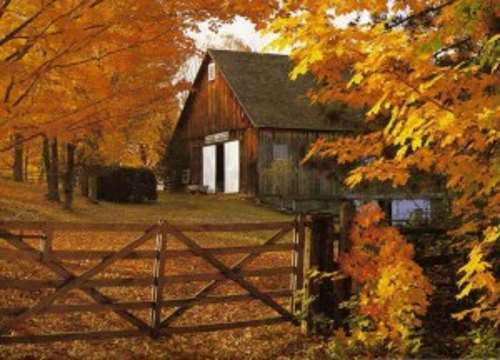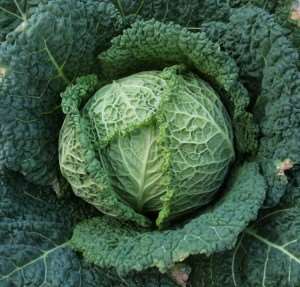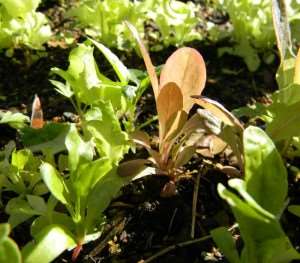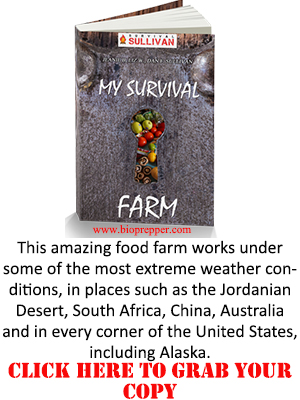The heat of summer seems like it will never end… and then suddenly, there’s just a hint of a cool breeze in the air.
Next thing you know, you’re freezing and the gardening year is basically over.
Before that happens, however, there’s a nice little window where you can tuck in another crop as the heat of summer fades into the crisp days of fall.
Obviously, this doesn’t apply to all climates (HA HA Wisconsin!!!) but it’s true for much of the country. Here in Florida we can garden year-round. In Tennessee, you can’t quite do that, but you can get a fall crop. In Alaska… well, I hope you like to eat seals.
As you plan out your fall garden for this year, here are a few cold-hardy favorites to consider.
10 Great Vegetables for Fall Gardening
Cabbage
Cabbage is a wonderful plant. It’s healthy for you, useful in a variety of dishes, and it can be made into delicious sauerkraut. Though it’s not as cold-hardy as some brassicas, there are small-headed types that will produce heads before the winter freezes your dirt. Plant some fast-yielding types like “Farao” or “Gonzalez” in summer (or early fall, depending on your climate) and you can be making sauerkraut in fall/winter.
Mustard
Mustard is one of my favorite cooked greens. Some people like the leaves in salads, but I prefer the burn to be cooked out of them first. An easy, low-demand crop, mustards also have the benefit of irritating nematodes.
Fava Beans
Ever wish you could grow beans in cold weather? You can! Favas are an easy-to-grow gourmet bean that doesn’t mind freezing weather, provided temperatures don’t go lower then the mid-teens. If you live in a colder climate, plant them earlier. They grow in grey and cold weather with nary a complaint. As an additional benefit, they fix nitrogen in your garden beds.
Broccoli
Broccoli, like its near kin the cabbage, can handle frosts and keep on producing. The one thing 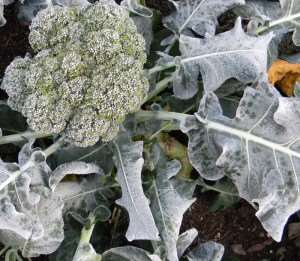 broccoli really seems to hate? Hot weather. Plant it after the heat of summer starts to subside for best results. Remember that with broccoli you can cut out the main head and then get multiple side shoots.
broccoli really seems to hate? Hot weather. Plant it after the heat of summer starts to subside for best results. Remember that with broccoli you can cut out the main head and then get multiple side shoots.
For more info on this excellent crop, check out its survival plant profile.
Peas
Like fava beans, peas don’t mind the cold. They’re also a good way to fill in your beds with a quick-composting nitrogen fixer in the fall after you’ve pulled in your main harvest of other vegetables. Though the yields aren’t incredible, my children love picking and eating fresh pea pods so I keep planting them.
Jerusalem Artichokes
Though you won’t see a yield until the following fall, fall is the time to start planting Jerusalem artichokes. In fact, you can only really plant them in cold weather since the tubers disintegrate and feed the next year’s growth when the soil warms up. To grow Jerusalem artichokes, grab some tubers and plant them late in the year when the weather is already cold. They’ll pop up in the spring and happily reach way up to the sky until they’re knocked down by frost the next fall. At that point you can dig up the huge clusters of roots and plant some more!
Kale
Of all the brassicas, kale has to be one of the cold-hardiest. I’ve seen it shake off temperatures in the teens with nary a bit of frost burn. It can even handle being buried in the snow. At a time of the year when more everything else has given up, kale bravely pushes onwards, giving you greens when there’s nothing else.
Beets
Beets are a solid fall crop that takes about two months from seed to root. They’re also very healthy for you and pickle wonderfully. Plant them in the late summer and you’ll have a belly full of borscht by Reformation Day.
Lettuce is one of those silly in-between crops. It’s not particularly frost tolerant… and it doesn’t like the heat. Leaf lettuces are a lot easier to grow than head lettuces so I stick to those, particularly in the fall. My favorite way to plant lettuce is to scatter seeds across a raked bed, then rake it lightly again and water well. We grow a big bed of lettuces in fall and cover it on frosty nights until it gets too cold to make the process worthwhile.
Sugar Cane
Most folks wouldn’t think about sugar cane as a fall crop; however, I always harvest my cane, then plant more in the fall and early winter, burying it snugly beneath the soil. In the warmth of spring the sugarcane emerges and is ready for harvest by frost. In mild climates (say Zone 8 and on south), sugarcane is a valuable perennial crop. You can learn more about planting it here.
So – are you inspired? I hope so! Get outside and enjoy the weather by preparing a big fall garden. There’s no time like the present… and fall gardening, unlike summer, is totally cool.
Source: thedailysheeple.com
Want to be as self-sufficient as possible? Want to master all the lost skills our grandfathers had??? >> Then you really need this amazing step-by-step guide. It is called The Lost Ways and it contains all the knowledge of our forefathers.
Here’s just a glimpse of what you’ll find in The Lost Ways:
From Ruff Simons, an old west history expert and former deputy, you’ll learn the techniques and methods used by the wise sheriffs from the frontiers to defend an entire village despite being outnumbered and outgunned by gangs of robbers and bandits, and how you can use their wisdom to defend your home against looters when you’ll be surrounded.
Native American ERIK BAINBRIDGE – who took part in the reconstruction of the native village of Kule Loklo in California, will show you how Native Americans build the subterranean roundhouse, an underground house that today will serve you as a storm shelter, a perfectly camouflaged hideout, or a bunker. It can easily shelter three to four families, so how will you feel if, when all hell breaks loose, you’ll be able to call all your loved ones and offer them guidance and shelter? Besides that, the subterranean roundhouse makes an awesome root cellar where you can keep all your food and water reserves year-round.
From Shannon Azares you’ll learn how sailors from the XVII century preserved water in their ships for months on end, even years and how you can use this method to preserve clean water for your family cost-free.
Mike Searson – who is a Firearm and Old West history expert – will show you what to do when there is no more ammo to be had, how people who wandered the West managed to hunt eight deer with six bullets, and why their supply of ammo never ran out. Remember the panic buying in the first half of 2013? That was nothing compared to what’s going to precede the collapse.
From Susan Morrow, an ex-science teacher and chemist, you’ll master “The Art of Poultice.” She says, “If you really explore the ingredients from which our forefathers made poultices, you’ll be totally surprised by the similarities with modern medicines.” Well…how would you feel in a crisis to be the only one from the group knowledgeable about this lost skill? When there are no more antibiotics, people will turn to you to save their ill children’s lives.
And believe it or not, this is not all…
Table Of Contents:
Making Your Own Beverages: Beer to Stronger Stuff
Ginger Beer: Making Soda the Old Fashioned Way
How North American Indians and Early Pioneers Made Pemmican
Spycraft: Military Correspondence During The 1700’s to 1900’s
Wild West Guns for SHTF and a Guide to Rolling Your Own Ammo
How Our Forefathers Built Their Sawmills, Grain Mills,and Stamping Mills
How Our Ancestors Made Herbal Poultice to Heal Their Wounds
What Our Ancestors Were Foraging For? or How to Wildcraft Your Table
How Our Ancestors Navigated Without Using a GPS System
How Our Forefathers Made Knives
How Our Forefathers Made Snow shoes for Survival
How North California Native Americans Built Their Semi-subterranean Roundhouses
Our Ancestors’Guide to Root Cellars
Good Old Fashioned Cooking on an Open Flame
Learning from Our Ancestors How to Preserve Water
Learning from Our Ancestors How to Take Care of Our Hygiene When There Isn’t Anything to Buy
How and Why I Prefer to Make Soap with Modern Ingredients
Temporarily Installing a Wood-Burning Stove during Emergencies
Making Traditional and Survival Bark Bread…….
Trapping in Winter for Beaver and Muskrat Just like Our Forefathers Did
How to Make a Smokehouse and Smoke Fish
Survival Lessons From The Donner Party
Get your paperback copy HERE
CHECK OUR survival and prepping solutions
If you found this article useful, please like our Facebook page and stay up to date with the latest articles.
WHAT TO READ NEXT:
HOW TO MAKE YOUR OWN BACON (STEP BY STEP GUIDE)
A RETURN TO THE OLD PATHS: HOW TO MAKE PEMMICAN LIKE THE NATIVE AMERICANS
20 LOST RECIPES FROM THE PIONEERS: WHAT THEY COOKED ON THEIR JOURNEY WESTWARD
SEVEN CLASSIC GREAT DEPRESSION ERA RECIPES GRANDMA USED TO MAKE
POTTED MEAT: A LOST SKILL OF LONG TERM MEAT STORAGE
BACK TO BASICS: HOW TO MAKE AND PRESERVE LARD
THE BEST WAY TO STOCKPILE VEGETABLES OFF-GRID
OLD FASHIONED PRESERVING-GRANDPA’S RECIPE FOR CURED SMOKED HAM
HOW TO MAKE GUNPOWDER THE OLD FASHIONED WAY
SURVIVAL HERBAL RECIPES FROM OUR ANCESTORS
HOW TO PRESERVE MEAT FOR SURVIVAL LIKE OUR GRANDFATHERS
OTHER USEFUL RESOURCES:
The 3 Pioneer Survival Lessons We Should Learn
The Most Effective Home Defense Strategies
Old School Hacks for Off-Grid Living
The Medical Emergency Crash Course

